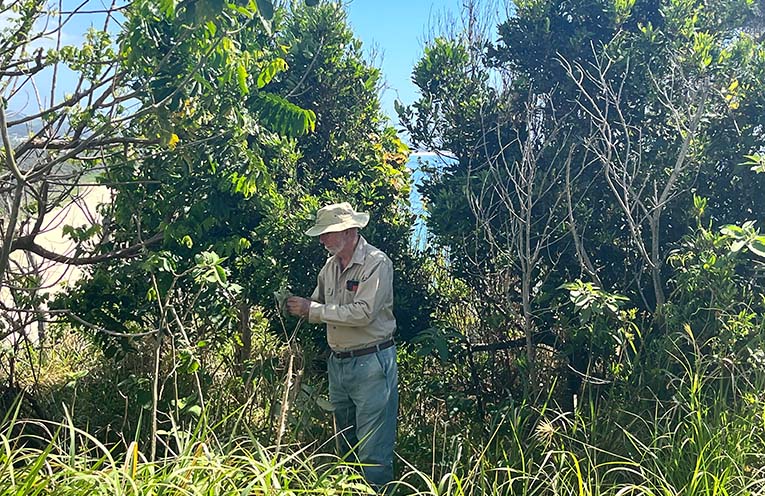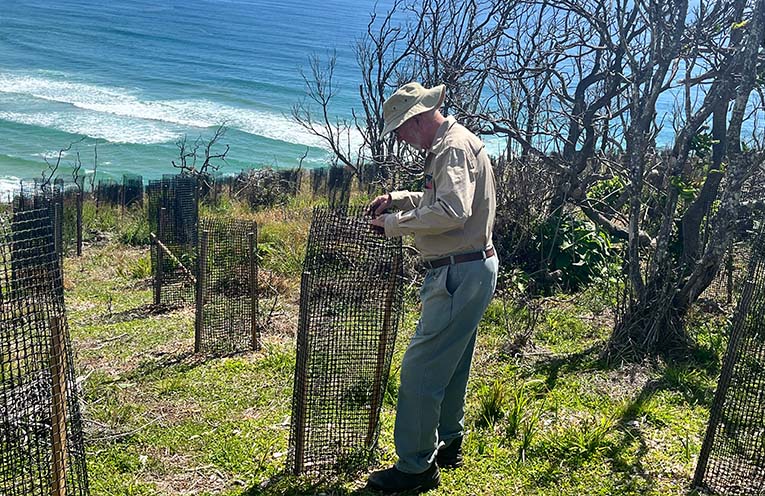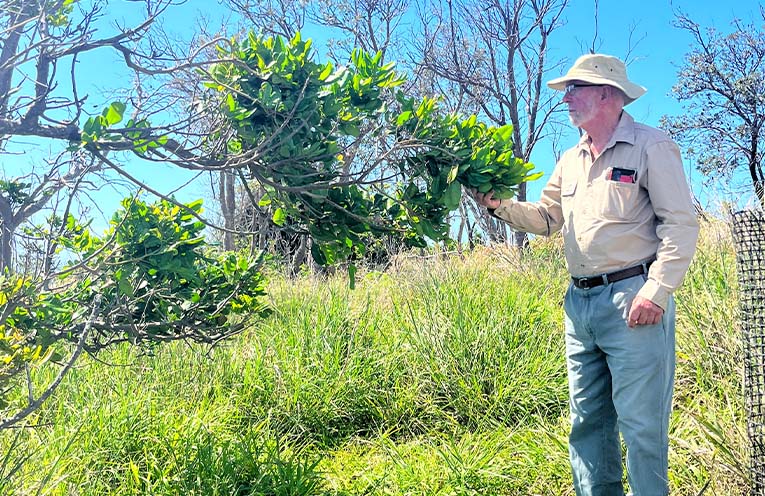
BOAMBEE Headland’s littoral rainforest is emerging from the devastating damage of the October 2021 hailstorm that stripped it almost bare of vital foliage.
The restoration is thanks to a team effort between Coffs Harbour Regional Landcare’s Sawtell.
 Advertise with News of The Area today.
Advertise with News of The Area today.It’s worth it for your business.
Message us.
Phone us – (02) 4981 8882.
Email us – media@newsofthearea.com.au
Dunecare/Boambee Headland group, City of Coffs Harbour’s Coastal Works, plant donations from GIOLink and students from St John Paul College.
Two years and two months since the storm that caused catastrophic defoliation and bark to be stripped from the
trees, signs of life returning are everywhere.
Sensing caution in the celebration, Barry Powells, President of Coffs Harbour Regional Landcare, told News Of The Area that extreme weather events are an unpredictable way of life today.
“There were three weather-related things that happened that caused almost irreparable damage to the whole of
the headland, with the hailstorm being the start of it,” Barry said.
“It killed so many trees and caused so much damage to the vegetation, followed by a really wet year, and a year after that it was below average rainfall for the first six months of this year.
“Those three things led to the desecration of the local environment up here,” he said, seated on a bench atop the
headland.
Having started planting in May 2022, the team then ran into the wet season.
“(This) didn’t affect the young plants but the ageing plants that had been stressed from salt laden air and hail damage were weakened and they possibly got fungal rot, which led to their demise.
“After the dry start to 2023 Coastal Works brought up 2,000 litres of water a week in Autumn to help us out.”
The long-term plan is to restore the headland’s natural ecosystem, which will probably take a whole generation to
achieve.
“To do this we will replant the species that used to populate the headland and try and get it to where it was in the
past.
“This is one of the most valuable headlands in the whole of Australia’s East Coast – it’s got three endangered ecological communities: Themeda grassland (kangaroo Grass), Floyd’s Grass and a coastal rainforest.”
Trees being planted to replace those dead and damaged by the storm on the northern side of the headland are endemic natives including: Casuarina, particularly the species that are feed trees to the Glossy Black Cockatoo, Banksia and coastal wattle.
Several other species are also being planted.
Along with the trees, getting good ground cover is important in weed management.
“Without good ground cover you will find a whole lot more weeds.
“Weed seeds have reduced germination with good ground cover which reduces their exposure to sunlight and also reduces soil temperature fluctuations,” said Barry.
The local GEOLink organisation has chosen this site to support as part of the company’s carbon offset program.
“GEOLink has supplied 200 trees in two consecutive years and are promising more next year, for which we are very grateful.”
Overall, 1000 trees have been planted.
Teamwork has played a crucial role in the restoration.
“After the storm we established a plan with Council’s Coastal Works bush regen team.”
Aaron Hartley, team leader at Coastal Works, has shared his extensive knowledge with the rest of the team.
“He knows more about plants than anyone else I know, and importantly the best place to plant everything,” said Barry.
“We asked the Landcare nursery to plant the species we needed, which they have done fantastically, collecting the seeds and growing young trees and shrubs.
“And we have an enthusiastic, on-going working relationship with John Paul College – they’ve been up here with
students planting trees and weeding with us on several occasions.”
The goal is to improve the habitat for all wildlife, both large and small.
“There’s a strong population of Swamp Wallabies up here, that’s why we ‘tree guard’ everything we plant, otherwise they’ll eat them.”
Bird-life is also returning to the site.
“We’ve seen a couple of species of honeyeaters and wrens, small finches, a migratory Noisy Pitta, they’re
slowly coming back,” he said.
Despite setbacks with extreme weather and some vandalism, the outlook is positive and well supported by locals keen to see Boambee Headland flourishing like it did pre-hailstorm.
By Andrea FERRARI


